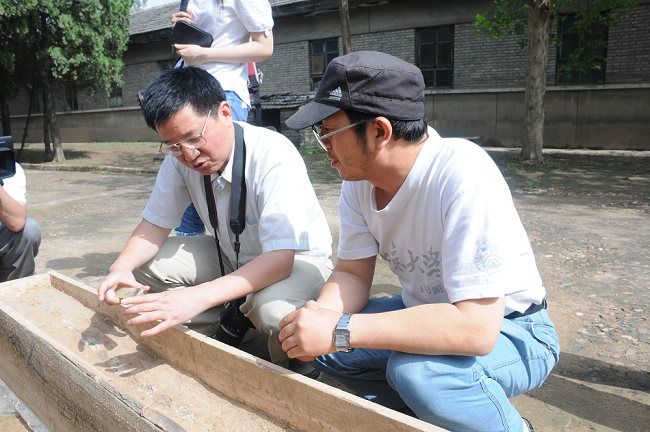Archaeologists uncover relics of Yao capital

Archaeologists examine an unearthed relic at the Taosi ruins in Linfen City, Shanxi Province.
The earliest state in Chinese history is widely believed to be the Xia Dynasty (c.2070-1600 BC), but a team of archaeologists has uncovered evidence suggesting the country’s origins go back even further. Findings from exploration of the ruins of Taosi in Linfen City, Shanxi Province, were announced at a June 18 press conference by the Chinese Academy of Social Sciences (CASS), with consensus reached that the site was the capital of the Yao period.
Archaeologists claimed there is a “strong possibility” that Taosi was the capital of the Yao period (2333-2234 BC). As one of the Three Sovereigns and Five Emperors in Chinese mythology, Emperor Yao (c.2356-2255 BC) ruled China in the middle reaches of the Yellow River before the Xia Dynasty.
According to historical records, Emperor Yao made Pingyang, the ancient name of Linfen in Shanxi, the capital. For a long time, however, the term only existed in historical texts and local folklore without scientific proof backed by archaeological findings.
“Archaeological exploration of Pingyang is critical to solving mysteries of the Three Sovereigns and Five Emperors era. It is an indispensable means of probing this key period,” said Wang Weiguang, CASS president. The Taosi ruins provide the strongest evidence to date in terms of time, location, scale and civilization that proves it was the capital of the Yao period, he added.
Since 1978, the Shanxi working group from the Institute of Archaeology at CASS has joined forces with the Linfen Cultural Bureau and Shanxi Provincial Institute of Archaeology to carry out excavations and studies of the Taosi site in Xiangfen County, Linfen. According to preliminary findings, Taosi was the best-zoned capital in prehistoric China with a history dating back between 4,000 and 4,300 years.
Investigation of cultural clusters at Taosi revealed a five-tier settlement and four-rank hierarchy at the site, indicating a complicated and rigidly hierarchical cultural society.
The political system of the era featured kingship and the initial shaping of etiquette, suggesting a rudimentary state in Taosi. However, its primitiveness, small scale and fragility led to its rapid decline.
The quadrangular royal palace, seasonal division for agricultural production, invention of the lunar calendar, use of Chinese characters and idea of China as the “middle kingdom” traced to the site were all inherited by the subsequent Xia, Shang (1600-1046 BC) and Zhou (1046-256 BC) dynasties.
The Taosi site provides the earliest evidence that the middle reaches of the Yellow River were home to an ancient civilized society.
“Taosi was the likely capital of the Yao period. Although confirmation will still take time, it is undeniable that archaeological excavations and research have transformed the Yao capital from myth to a true part of Chinese history,” said Wang Wei, CASS Member and head of the institute.
Wang Zhenzhong, deputy director of the Institute of History at CASS, said Taosi is a unique site in that its excavations integrate historical and archaeological methodologies. Such integration makes it feasible to illustrate social development in the Yao, Shun (c.2294-2184 BC) and Yu (c.2200-2100 BC) periods from an archaeological perspective, thereby changing the historical view that it was a primitive society and rewriting ancient Chinese history, he said.
Huo Wenqi is a reporter at the Chinese Social Sciences Today.

 PRINT
PRINT CLOSE
CLOSE